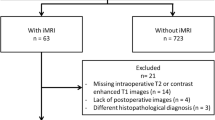Abstract
Purpose
Our hypothesis was that pituitary macroadenomas show different areas of consistency detectable by enhanced magnetic resonance imaging (MRI) with Dynamic study during gadolinium administration.
Materials and methods
We analysed 21 patients with pituitary macroadenomas between June 2013 and June 2015. All patients underwent trans-sphenoidal surgery and neurosurgeon described macroadenomas consistency. Similarly, two neuroradiologists manually drew regions of interest (ROIs) inside the solid-appearing portions of macroadenoma and in the normal white matter both on dynamic and post-contrast acquisitions. The ratio between these ROIs, defined as Signal Intensity Ratio (SIR), allowed obtaining signal intensity curves over time on dynamic acquisition and a single value on post-contrast MRI. SIR values best differentiating solid from soft macroadenoma components were calculated and correlated with pathologic patterns. A two-sample T test and empiric receiver operating characteristic (ROC) curve of SIR was performed.
Results
According to ROC analysis, the SIR value of 1.92, obtained by dynamic acquisition, best distinguished soft and hard components. All the specimens from soft components were characterized by high cellularity, high representation of vascularization and micro-haemorrhage and low percentage of collagen content. The reverse was evident in hard components.
Conclusions
We demonstrated that dynamic MRI acquisition could distinguish with good accuracy macroadenomas consistency.




Similar content being viewed by others
References
Alimohamadi M, Sanjari R, Mortazavi A, Shirani M, Moradi Tabriz H, Hadizadeh Kharazi H, Amirjamshidi A (2004) Predictive value of diffusion-weighted MRI for tumor consistency and resection rate of nonfunctional pituitary macroadenomas. Acta Neurochir 156:2245–2252
Pierallini A, Caramia F, Falcone C, Tinelli E, Paonessa A, Ciddio AB, Fiorelli M, Bianco F, Natalizi S, Ferrante L, Bozzao L (2006) Pituitary macroadenomas: preoperative evaluation of consistency with diffusion- weighted MR imaging- initial experience. Radiology 239:223–231
Snow RB, Lavyne MH, Lee BC, Morgello S, Patterson RH Jr (1986) Craniotomy versus transphenoidal excision of large pituitary tumors: the usefulness of magnetic resonance imaging in guiding the operative approach. Neurosurgery 19:59–64
Wilson CB (1979) Neurosurgical management of large and invasive pituitary tumors. In: Tindall GT, Collins WF (eds) Clinical management of pituitary disorders. Raven, New York, pp 335–342
Naganuma H, Satoh E, Nukui H (2002) Technical considerations of transphenoidal removal of fibrous pituitary adenomas and evaluation of collagen content and subtype in the adenomas. Neurol Med Chir 42:202–212
Mahmaoud OM, Tominaga A, Amatya VJ, Ohtaki M, Sugiyama K, Sakoguchi T, Kinoshita Y (2011) Role of PROPELLER diffusion-weighted imaging and apparent diffusion coefficient in the evaluation of pituitary adenomas. Eur J Radiol 80:412–417
Iuchi T, Saeki N, Tanaka M, Sunami K, Yamaura A (1998) MRI prediction of fibrous pituitary adenomas. Acta Neurochir 140:779–786
Snow RB, Johnson CE, Morgello S, Lavyne MH, Patterson RH Jr (1990) Is magnetic resonance imaging useful in guiding the operative approach to large pituitary tumors? Neurosurgery 26:801–803
Sakai N, Koizumi S, Yamashita S, Takehara Y, Sakahara H, Baba S, Oki Y, Hiramatsu H, Namba H (2013) Arterial spin-labeled perfusion imaging reflects vascular density in non-functioning pituitary macroadenomas. AJNR Am J Neuroradiol 34:2139–2143
Boellis A, Espagnet MC, Romano A, Trillò G, Raco A, Moraschi M, Bozzao A (2014) Dynamic intraoperative MRI in transsphenoidal resection of pituitary macroadenomas: a quantitative analysis. J Magn Reson Imaging 40:668–673
Yamamoto J, Kakeda S, Shimajiri S, Takahashi M, Watanabe K, Kai Y, Moriya J, Korogi Y, Nishizawa S (2014) Tumor consistency of pituitary macroadenomas: predictive analysis on the basis of imaging features with contrast-enhanced 3D FIESTA at 3T. AJNR Am J Neuroradiol 35:297–303
Chakrabortty S, Oi S, Yamaguchi M, Tamaki N, Matsumoto S (1993) Growth hormone-producing pituitary adenomas: MR characteristics and pre-and postoperative evaluation. Neurol Med Chir 33:81–85
Boxerman JL, Rogg JM, Donahue JE, Machan JT, Goldman MA, Doberstein CE (2010) Preoperative MRI evaluation of pituitary macroadenoma: imaging features predictive of successful transsphenoidal surgery. AJR Am J Roentgenol 195:720–728
Hagiwara A, Inoue Y, Wakasa K, Haba T, Tashiro T, Miyamoto T (2003) Comparison of growth hormone-producing and non-growth hormone-producing pituitary adenomas: imaging characteristics and pathologic correlation. Radiology 228:533–538
Bartynski WS, Lin L (1997) Dynamic and conventional spin-echo MR of pituitary microlesions. AJNR Am J Neuroradiol 18:965–972
Pergolizzi RS Jr, Nabavi A, Schwartz RB, Hsu L, Wong TZ, Martin C, Black PM, Joesz FA (2001) Intra-operative MR guidance during trans-sphenoidal pituitary resections: preliminary results. J Magn Reson Imaging 13:136–141
Guo Q, Young WF, Erickson D, Erickson B (2015) Usefulness of dynamic MRI enhancement measures for the diagnosis of ACTH-producing pituitary adenomas. Clin Endocrinol 82:267–273
Powell DF, Baker HL Jr, Laws ER Jr (1974) The primary angiographic findings in pituitary adenomas. Radiology 110:589–595
Compliance with ethical standards
Conflict of interest
The authors declare that they have no conflict of interest.
Author information
Authors and Affiliations
Corresponding author
Additional information
An erratum to this article is available at http://dx.doi.org/10.1007/s11102-016-0774-6.
Rights and permissions
About this article
Cite this article
Romano, A., Coppola, V., Lombardi, M. et al. Predictive role of dynamic contrast enhanced T1-weighted MR sequences in pre-surgical evaluation of macroadenomas consistency. Pituitary 20, 201–209 (2017). https://doi.org/10.1007/s11102-016-0760-z
Published:
Issue Date:
DOI: https://doi.org/10.1007/s11102-016-0760-z




